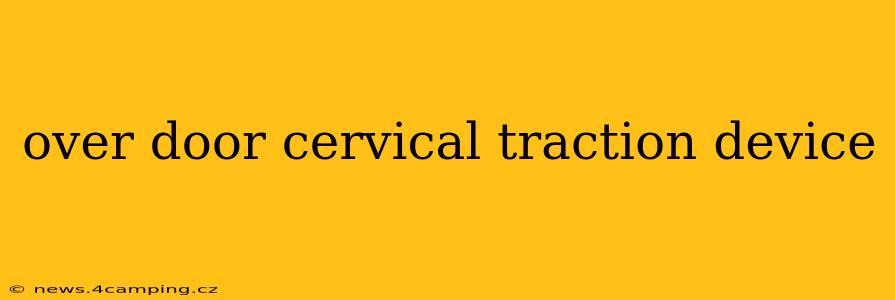Neck pain? Stiffness? Headaches? You're not alone. Millions experience these symptoms, and many find relief through cervical traction. An over-the-door cervical traction device offers a convenient and potentially effective way to alleviate neck pain at home. But how does it work, is it right for you, and what should you consider before using one? This comprehensive guide answers these questions and more.
What is a Cervical Traction Device?
A cervical traction device is a tool designed to gently stretch the neck, separating the vertebrae and relieving pressure on the spinal nerves and discs. This stretching can help alleviate pain, improve range of motion, and reduce inflammation. Over-the-door devices are particularly convenient because they require no extra equipment or setup beyond a sturdy door frame. They typically consist of a head harness and a system of straps and weights (or a spring mechanism) to provide the traction force.
How Does an Over-the-Door Cervical Traction Device Work?
These devices function by applying a controlled amount of traction to the neck. You position the head harness, secure it snugly, and then adjust the weight or tension to a comfortable level. The weight gradually pulls your head upwards, creating the traction effect. This separation of the vertebrae can help:
- Reduce pressure on spinal nerves: This is a major source of neck pain for many individuals.
- Increase space between discs: This helps to reduce inflammation and disc herniation.
- Improve blood circulation: Increased blood flow can promote healing and reduce stiffness.
- Stretch neck muscles: This can help to relieve muscle spasms and tightness.
Is an Over-the-Door Cervical Traction Device Right for Me?
While these devices can be beneficial, they are not a solution for everyone. It's crucial to consult your doctor or physical therapist before using any cervical traction device. They can assess your specific condition and determine if it's an appropriate treatment option. Conditions where cervical traction might be helpful include:
- Muscle spasms: Gentle traction can help relax tense neck muscles.
- Minor disc herniations: Traction can help alleviate pressure on the discs.
- Neck stiffness: Improving range of motion is a common benefit.
- Cervical spondylosis: (with doctor's approval) This degenerative condition can sometimes benefit from traction.
However, cervical traction is not recommended for people with:
- Severe osteoporosis: Increased risk of fracture.
- Unstable neck injuries: Could worsen the condition.
- Recent neck surgery: Could damage the healing tissues.
- Tumors or infections in the neck: Traction could spread the infection.
- Hypertension (high blood pressure): Consult your doctor.
How Do I Use an Over-the-Door Cervical Traction Device?
The specific instructions will vary depending on the device. However, the general steps typically include:
- Secure the device: Ensure the door is sturdy and the device is properly installed in the door frame.
- Adjust the head harness: Make sure it fits comfortably and securely around your head.
- Adjust the weight or tension: Start with a low setting and gradually increase the traction as you feel comfortable. Never force it.
- Maintain proper posture: Keep your shoulders relaxed and avoid jerking movements.
- Follow the recommended duration: Typically, sessions last for a few minutes initially, gradually increasing as tolerated.
- Listen to your body: Stop if you experience any increased pain, dizziness, or discomfort.
What Are the Potential Side Effects of Using a Cervical Traction Device?
While generally safe when used correctly, potential side effects include:
- Increased pain: If you feel more pain, stop immediately.
- Dizziness: This can occur due to changes in blood pressure.
- Headaches: Stop use and consult your doctor.
- Muscle soreness: This is normal but should subside.
- Neck stiffness (rare): Properly using a device should reduce stiffness.
How Long Does It Take to See Results from Cervical Traction?
The time it takes to see results varies depending on the individual and the severity of the condition. Some people experience relief after a few sessions, while others may require several weeks of consistent use. It's essential to be patient and consistent.
What are the Different Types of Over-the-Door Cervical Traction Devices?
Several types exist, varying in features such as weight adjustment mechanisms, head harness designs, and additional support features. Read reviews before purchasing to find a device that suits your needs and preferences.
Can I Use Cervical Traction With Other Treatments?
Cervical traction is often used in conjunction with other treatments such as physical therapy, medication, and heat/ice therapy. Consult your doctor or physical therapist to determine the best treatment plan for you. They can help you integrate traction safely and effectively into your overall care.
This guide provides a general overview. Always prioritize consultation with a healthcare professional before using any cervical traction device to ensure its suitability for your individual needs and health status. Improper use can worsen your condition.
